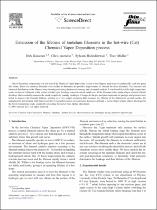 ResearchSpace
ResearchSpace
Extension of the lifetime of tantalum filaments in the hot-wire (Cat) 3 Chemical Vapor Deposition process
JavaScript is disabled for your browser. Some features of this site may not work without it.
- ResearchSpace
- →
- Research Publications/Outputs
- →
- Journal Articles
- →
- View Item
| dc.contributor.author |
Knoesen, D

|
|
| dc.contributor.author |
Arendse, C

|
|
| dc.contributor.author |
Halindintwali, S

|
|
| dc.contributor.author |
Muller, T

|
|
| dc.date.accessioned | 2008-05-29T07:14:57Z | |
| dc.date.available | 2008-05-29T07:14:57Z | |
| dc.date.issued | 2008-01 | |
| dc.identifier.citation | Knoesen, D, Arendse, CJ, Halindintwali, S and Muller, T. 2008. Extension of the lifetime of tantalum filaments in the hot-wire (Cat) 3 Chemical Vapor Deposition process. Thin Solid Films, Vol. 516(5), pp 822-825 | en |
| dc.identifier.issn | 0040-6090 | |
| dc.identifier.uri | http://hdl.handle.net/10204/2257 | |
| dc.description | Copyright: 2007 Elsevier Science B.V | en |
| dc.description.abstract | One of the prime components of a hot-wire (Cat) Chemical Vapor Deposition system is the filament used to pyro-catalytically crack the gases like silane. Burnt out tantalum filaments were studied to determine the possible improvement of lifetime for these filaments. The structure and chemical distribution in the filament were investigated, using electron microscopy and elemental analysis. It was found that at the high temperature centre section of a filament a thin surface silicide layer develops around a central metal core. At the filament ends a surface layer of metal silicide develops, that eventually consume the metal completely, causing breakages. Changes in the pre- and post-treatments of gas type and pressure were tested to improve the filament lifetime, arriving at a very simple procedure that increases the lifetime of the filament to several months. By annealing the hot filament both before and after a deposition run in a low pressure hydrogen ambient, a surface layer of pure silicon developed at the lower temperature ends, essentially protecting the metal from further silicidation. | en |
| dc.language.iso | en | en |
| dc.publisher | Elsevier Science B.V | en |
| dc.subject | Tantalum | en |
| dc.subject | Filaments | en |
| dc.subject | Chemical vapour deposition | en |
| dc.subject | Energy dispersive spectrography | en |
| dc.subject | Silicide | en |
| dc.subject | Lifetime | en |
| dc.subject | Electron microscopy | en |
| dc.subject | Hydrogen | en |
| dc.title | Extension of the lifetime of tantalum filaments in the hot-wire (Cat) 3 Chemical Vapor Deposition process | en |
| dc.type | Article | en |
| dc.identifier.apacitation | Knoesen, D., Arendse, C., Halindintwali, S., & Muller, T. (2008). Extension of the lifetime of tantalum filaments in the hot-wire (Cat) 3 Chemical Vapor Deposition process. http://hdl.handle.net/10204/2257 | en_ZA |
| dc.identifier.chicagocitation | Knoesen, D, C Arendse, S Halindintwali, and T Muller "Extension of the lifetime of tantalum filaments in the hot-wire (Cat) 3 Chemical Vapor Deposition process." (2008) http://hdl.handle.net/10204/2257 | en_ZA |
| dc.identifier.vancouvercitation | Knoesen D, Arendse C, Halindintwali S, Muller T. Extension of the lifetime of tantalum filaments in the hot-wire (Cat) 3 Chemical Vapor Deposition process. 2008; http://hdl.handle.net/10204/2257. | en_ZA |
| dc.identifier.ris | TY - Article AU - Knoesen, D AU - Arendse, C AU - Halindintwali, S AU - Muller, T AB - One of the prime components of a hot-wire (Cat) Chemical Vapor Deposition system is the filament used to pyro-catalytically crack the gases like silane. Burnt out tantalum filaments were studied to determine the possible improvement of lifetime for these filaments. The structure and chemical distribution in the filament were investigated, using electron microscopy and elemental analysis. It was found that at the high temperature centre section of a filament a thin surface silicide layer develops around a central metal core. At the filament ends a surface layer of metal silicide develops, that eventually consume the metal completely, causing breakages. Changes in the pre- and post-treatments of gas type and pressure were tested to improve the filament lifetime, arriving at a very simple procedure that increases the lifetime of the filament to several months. By annealing the hot filament both before and after a deposition run in a low pressure hydrogen ambient, a surface layer of pure silicon developed at the lower temperature ends, essentially protecting the metal from further silicidation. DA - 2008-01 DB - ResearchSpace DP - CSIR KW - Tantalum KW - Filaments KW - Chemical vapour deposition KW - Energy dispersive spectrography KW - Silicide KW - Lifetime KW - Electron microscopy KW - Hydrogen LK - https://researchspace.csir.co.za PY - 2008 SM - 0040-6090 T1 - Extension of the lifetime of tantalum filaments in the hot-wire (Cat) 3 Chemical Vapor Deposition process TI - Extension of the lifetime of tantalum filaments in the hot-wire (Cat) 3 Chemical Vapor Deposition process UR - http://hdl.handle.net/10204/2257 ER - | en_ZA |





